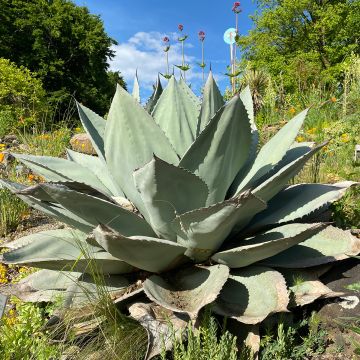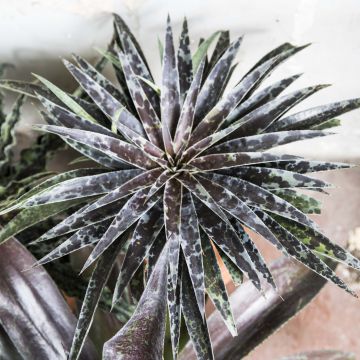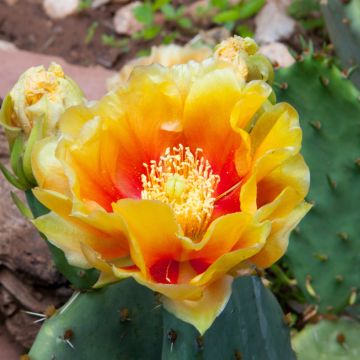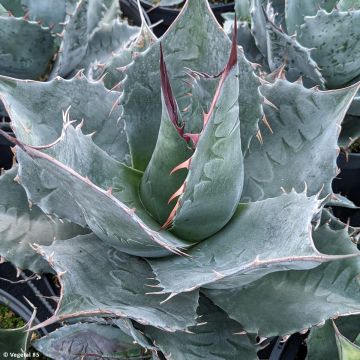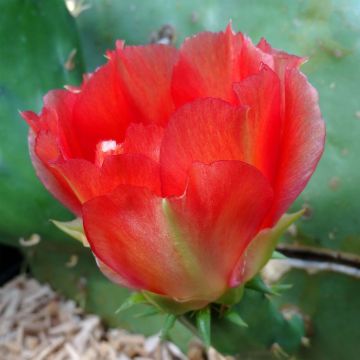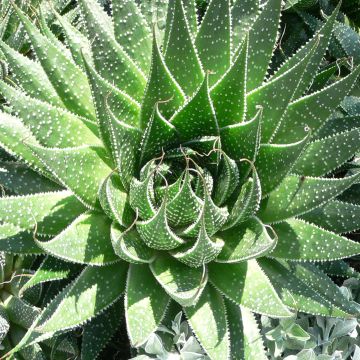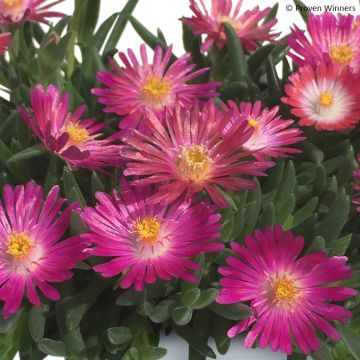

Cereus forbesii Spiralis
Cereus forbesii Spiralis
Cereus forbesii Spiralis
Ming Thing Cactus, Forbes' Cereus
I'm sorry to have to leave a negative review, the cactus arrived rotten at the base, less beautiful than in the picture but that's a minor issue. The soil in the pot was waterlogged, closed in a box for a few days, it's not surprising that it rotted.
Maryline , 14/05/2024
This item cannot be shipped to the selected country
Delivery charge from €5.90
More information
Schedule delivery date,
and select date in basket
This plant carries a 12 months recovery warranty
More information
We guarantee the quality of our plants for a full growing cycle, and will replace at our expense any plant that fails to recover under normal climatic and planting conditions.
From €5.90 for pickup delivery and €6.90 for home delivery
Express home delivery from €8.90.
Does this plant fit my garden?
Set up your Plantfit profile →
Description
Cereus forbesii 'Spiralis' is a magnificent plant, forming an imposing candelabra with spiral-shaped stems, very curious looking. This species forms a bushy shrub with a tree-like habit that can reach up to 4m (13ft) in height, with upright stems that branch strongly from the base, ranging from deep green to bluish-green in colour. Its few ribs are very deep and spiral to the right and left, sometimes changing direction during growth. In summer it bears abundant nocturnal flowers, white and very nectar-rich, measuring 15cm (6in) in diameter, which only close in the late morning. Very floriferous, fast-growing and highly drought-resistant, it is a visually striking plant perfectly suited for rockeries in hotter regions, or for cultivation in large pots indoors or in a conservatory or greenhouse, in colder regions.
Cereus forbesii 'Spiralis' is a natural mutation of the type species, discovered in 1992 by the Argentine botanist Omar Ferrari. Cereus forbesii belongs to the vast family of Cactaceae. It is a plant that withstands drought and heat well and tolerates temperatures as low as -2°C (28.4°F), especially if the soil is perfectly drained and dry. Cultivate it in a pot, in full sun, in a well-draining substrate, preferably sandy, composed of equal parts of potting soil, sand and garden soil. Young plants prefer shaded, non-scorching exposures. Outdoor cultivation in regions with mild winters can be done against a well positioned wall or in a dry rockery.
Cereus forbesii 'Spiralis' is a very attractive cactus due to its spiral-shaped ribs and prolific flowering. Because of its particularly rapid growth and imposing size, it requires large containers and regular repotting. They are upright to bushy succulent perennials that tend to produce numerous shoots at their base. They reach about 3m (10ft) in all directions. Each stem is erect, 10 to 12cm (4 to 5in) in diameter, with a dark green epidermis covered with a bloom that sometimes gives it a bluish hue. They have 5 to 9 deep and distinct ribs, which spiral to the right or left, a tendency that can change during growth. The ribs have sparsely hairy areoles with short, stiff and not very numerous spines. Plants over 4-5 years old flower from July to September, offering surprisingly large funnel-shaped flowers, 15 to 25cm (6 to 10in) in diameter, white with light brown sepals.
In hotter and dryer regions, Cereus forbesii 'Spiralis' will find its place in a dry and sunny rockery or on a wild slope. Elsewhere it can be planted in a pot, to be stored away when the first frosts arrive and not watered until vegetation resumes in spring. It can be combined with other cacti such as echinocactus, ferocactus, astrophytum, and mammillaries to create miniature desert gardens, or it can be placed alone in a pot to decorate a windowsill or a corner of a conservatory.
Report an error about the product description
Cereus forbesii Spiralis in pictures
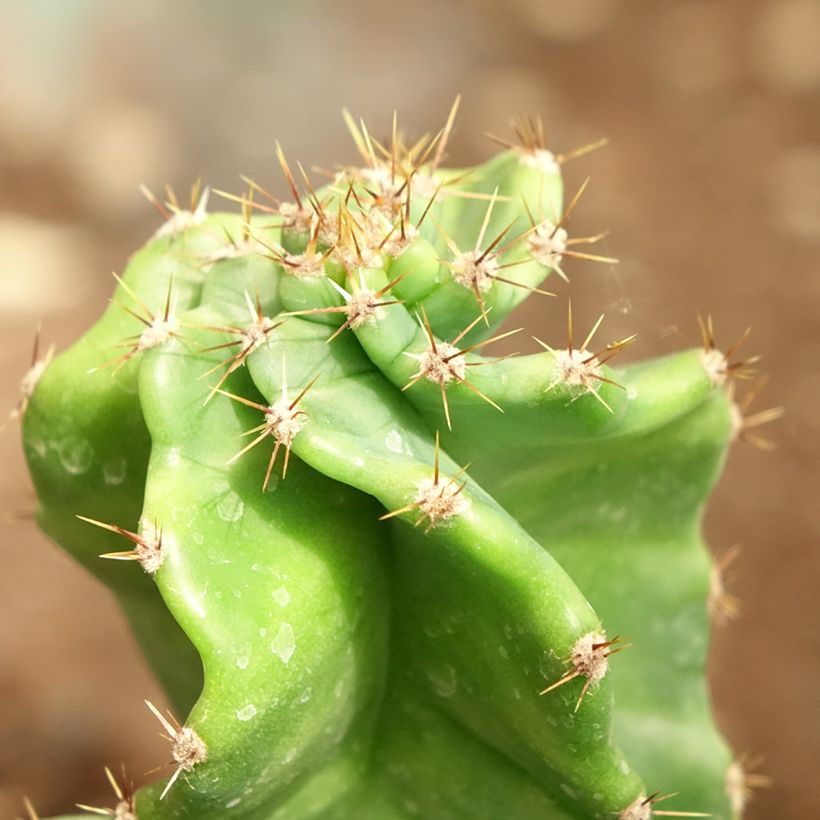

Flowering
Foliage
Plant habit
Botanical data
Cereus
forbesii
Spiralis
Cactaceae
Ming Thing Cactus, Forbes' Cereus
North America
Other Cacti and succulents
Planting and care
Drought and heat resistant, plant Cereus forbesii 'Spiralis' in full sun or partial shade in light, well-draining, sandy to rocky soil. It can tolerate temperatures as low as -2°C (28.4°F) in dry and well-drained soil. Grow it in the ground in a rockery or against a well positioned wall in hotter regions. Elsewhere, plant it in a pot using an equal mix of garden soil, compost, and sand. Store it dry throughout the winter in a bright room between 5°C (41°F) and 10°C (50°F). Water sparingly from March to October.
Planting period
Intended location
Care
-
, onOrder confirmed
Reply from on Promesse de fleurs
Haven't found what you were looking for?
Hardiness is the lowest winter temperature a plant can endure without suffering serious damage or even dying. However, hardiness is affected by location (a sheltered area, such as a patio), protection (winter cover) and soil type (hardiness is improved by well-drained soil).

Photo Sharing Terms & Conditions
In order to encourage gardeners to interact and share their experiences, Promesse de fleurs offers various media enabling content to be uploaded onto its Site - in particular via the ‘Photo sharing’ module.
The User agrees to refrain from:
- Posting any content that is illegal, prejudicial, insulting, racist, inciteful to hatred, revisionist, contrary to public decency, that infringes on privacy or on the privacy rights of third parties, in particular the publicity rights of persons and goods, intellectual property rights, or the right to privacy.
- Submitting content on behalf of a third party;
- Impersonate the identity of a third party and/or publish any personal information about a third party;
In general, the User undertakes to refrain from any unethical behaviour.
All Content (in particular text, comments, files, images, photos, videos, creative works, etc.), which may be subject to property or intellectual property rights, image or other private rights, shall remain the property of the User, subject to the limited rights granted by the terms of the licence granted by Promesse de fleurs as stated below. Users are at liberty to publish or not to publish such Content on the Site, notably via the ‘Photo Sharing’ facility, and accept that this Content shall be made public and freely accessible, notably on the Internet.
Users further acknowledge, undertake to have ,and guarantee that they hold all necessary rights and permissions to publish such material on the Site, in particular with regard to the legislation in force pertaining to any privacy, property, intellectual property, image, or contractual rights, or rights of any other nature. By publishing such Content on the Site, Users acknowledge accepting full liability as publishers of the Content within the meaning of the law, and grant Promesse de fleurs, free of charge, an inclusive, worldwide licence for the said Content for the entire duration of its publication, including all reproduction, representation, up/downloading, displaying, performing, transmission, and storage rights.
Users also grant permission for their name to be linked to the Content and accept that this link may not always be made available.
By engaging in posting material, Users consent to their Content becoming automatically accessible on the Internet, in particular on other sites and/or blogs and/or web pages of the Promesse de fleurs site, including in particular social pages and the Promesse de fleurs catalogue.
Users may secure the removal of entrusted content free of charge by issuing a simple request via our contact form.
The flowering period indicated on our website applies to countries and regions located in USDA zone 8 (France, the United Kingdom, Ireland, the Netherlands, etc.)
It will vary according to where you live:
- In zones 9 to 10 (Italy, Spain, Greece, etc.), flowering will occur about 2 to 4 weeks earlier.
- In zones 6 to 7 (Germany, Poland, Slovenia, and lower mountainous regions), flowering will be delayed by 2 to 3 weeks.
- In zone 5 (Central Europe, Scandinavia), blooming will be delayed by 3 to 5 weeks.
In temperate climates, pruning of spring-flowering shrubs (forsythia, spireas, etc.) should be done just after flowering.
Pruning of summer-flowering shrubs (Indian Lilac, Perovskia, etc.) can be done in winter or spring.
In cold regions as well as with frost-sensitive plants, avoid pruning too early when severe frosts may still occur.
The planting period indicated on our website applies to countries and regions located in USDA zone 8 (France, United Kingdom, Ireland, Netherlands).
It will vary according to where you live:
- In Mediterranean zones (Marseille, Madrid, Milan, etc.), autumn and winter are the best planting periods.
- In continental zones (Strasbourg, Munich, Vienna, etc.), delay planting by 2 to 3 weeks in spring and bring it forward by 2 to 4 weeks in autumn.
- In mountainous regions (the Alps, Pyrenees, Carpathians, etc.), it is best to plant in late spring (May-June) or late summer (August-September).
The harvesting period indicated on our website applies to countries and regions in USDA zone 8 (France, England, Ireland, the Netherlands).
In colder areas (Scandinavia, Poland, Austria...) fruit and vegetable harvests are likely to be delayed by 3-4 weeks.
In warmer areas (Italy, Spain, Greece, etc.), harvesting will probably take place earlier, depending on weather conditions.
The sowing periods indicated on our website apply to countries and regions within USDA Zone 8 (France, UK, Ireland, Netherlands).
In colder areas (Scandinavia, Poland, Austria...), delay any outdoor sowing by 3-4 weeks, or sow under glass.
In warmer climes (Italy, Spain, Greece, etc.), bring outdoor sowing forward by a few weeks.

































